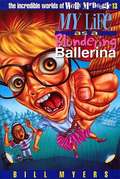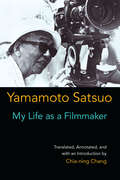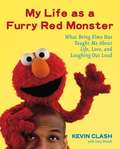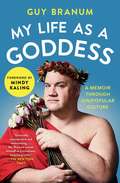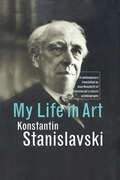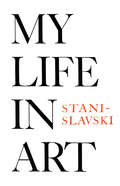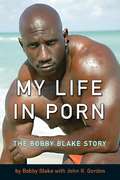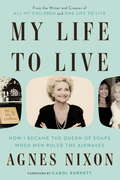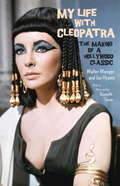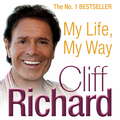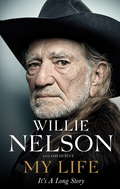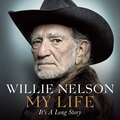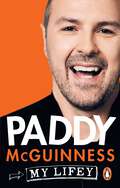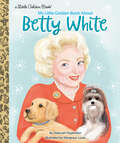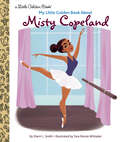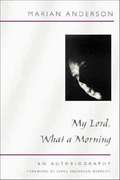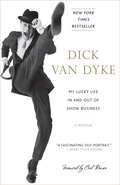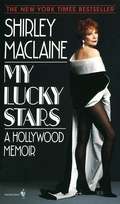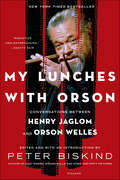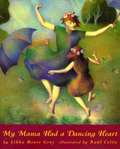- Table View
- List View
My Life as a Blundering Ballerina (The Incredible Worlds of Wally McDoogle #13)
by Bill MyersAt the suggestion of their speech teacher, Wally and his good friend Wall Street agree to switch places for three days to prove whether boys or girls are better.
My Life as a Filmmaker
by Chia-Ning Chang Satsuo YamamotoIn his posthumous autobiography, Watakushi no eiga jinsei (1984), Yamamoto reflects on his career and legacy: beginning in the prewar days as an assistant director in a well-established film company under the master Naruse Mikio, to his wide-ranging experiences as a filmmaker, including his participation in the tumultuous Toho Labor Upheaval soon after Japan’s defeat in World War II and his struggles as an independent filmmaker in the 1950s and 1960s before returning to work within the mainstream industry. In the process, he established himself as one of the most prominent and socially engaged film artists in postwar Japan. Imbued with vibrant social realism and astute political commentary, his filmic genres ranged widely from melodramas, period films from the Tokugawa era, samurai action jidaigeki, social satires, and antiwar films. Providing serious insights into and trenchant critique of the moral corruption in Japanese politics, academe, industry, and society, Yamamoto at the same time produced highly successful films that offered drama and entertainment for Japanese and international moviegoers. His considerable artistic distinction, strong social and political consciousness, and filmic versatility have earned him a unique and distinguished position among Japan’s world-class film directors. In addition to detailed annotations of the autobiography, translator Chia-ning Chang offers a comprehensive introduction to the career and the significance of Yamamoto and his works in the context of Japanese film history. It contextualizes Yamamoto’s life and works in the historical and cultural zeitgeist of prewar, wartime, and postwar Japan before scrutinizing the unique qualities of his narrative voice and social conscience as a film artist.
My Life as a Furry Red Monster
by Kevin ClashHello, Everybody!The furry red monster known as Elmo has charmed his way into hearts and homes throughout the world with his unmistakable laugh, over-the-top enthusiasm, and boundless love. Elmo's appeal is nothing short of magical. Kids adore him, and parents find him irresistible. What is it about this little monster?Meet Kevin Clash, the man behind the Muppet and the unassuming heart and soul of Elmo. At last, the puppeteer who has performed Elmo for nearly twenty years comes out from behind the stage to share his story. Weaving together his memories of growing up with the life lessons gained from his furry red alter ego, Kevin reveals himself to be as caring, and as eager to grow and learn and love, as the very special character he brings to life.You will discover how young Kevin honed his talent entertaining the kids in his mother's home day care with puppets he made from slippers and coat liners; how, as a struggling young artist, he realized his dream to meet and then work for his idol, Muppet creator Jim Henson; and how each and every day of performing Elmo reinforces for him what is most important in life.As Kevin has been inspired by Elmo, now we can all learn from his furry red ways. Kevin's (and Elmo's) thoughts on love, creativity, friendship, and optimism remind us of life's simple truths and ultimately encourage us all to be a little bit more like Elmo--to live with joy, to love more easily, and to laugh more often.
My Life as a Furry Red Monster: What Being Elmo Has Taught Me About Life, Love, and Laughing Out Loud
by Kevin ClashFrom the Book Jacket: Hello, Everybody! The furry red monster known as Elmo has charmed his way into hearts and homes throughout the world with his unmistakable laugh, over-the-top enthusiasm, and boundless love. Elmo's appeal is nothing short of magical. Kids adore him, and parents find him irresistible. What is it about this little monster? Meet Kevin Clash, the man behind the Muppet and the unassuming heart and soul of Elmo. At last, the puppeteer who has performed Elmo for nearly twenty years comes out from behind the stage to share his story. Weaving together his memories of growing up with the life lessons gained from his furry red alter ego, Kevin reveals himself to be as caring, and as eager to grow and learn and love, as the very special character he brings to life. You will discover how young Kevin honed his talent entertaining the kids in his mother's home day care with puppets he made from slippers and coat liners; how, as a struggling young artist, he realized his dream to meet and then work for his idol, Muppet creator Jim Henson; and how each and every day of performing Elmo reinforces for him what is most important in life. As Kevin has been inspired by Elmo, now all learn from his furry red ways. Kevin's (and Elmo's) thoughts on love, creativity, friendship, and optimism remind us of life's simple truths and ultimately encourage us all to be a little bit more like Elmo-to live with joy, to love more easily, and to laugh more often. KEVIN CLASH began making his own puppets and performing for live audiences when he was a boy. He turned his childhood obsession into a professional passion, forging a career in television and making an indelible mark on children's imaginations. Kevin has been with Sesame Street for twenty-six years and is coexecutive producer of "Elmo's World." He has won three Emmy Awards for Outstanding Performer in a Children's Series and six for his work as coexecutive producer of an Outstanding Pre-School Children's Series. He has a daughter, Shannon, and lives in New York City.
My Life as a Goddess: A Memoir through (Un)Popular Culture
by Guy Branum&“Smart, fast, clever, and funny (As f*ck!)&” (Tiffany Haddish), this collection of side-splitting and illuminating essays by the popular stand-up comedian, alum of Chelsea Lately and The Mindy Project, and host of truTV&’s Talk Show the Game Show is perfect for fans of the New York Times bestsellers Why Not Me? by Mindy Kaling and We Are Never Meeting in Real Life by Samantha Irby.From a young age, Guy Branum always felt as if he were on the outside looking in. From a stiflingly boring farm town, he couldn&’t relate to his neighbors. While other boys played outside, he stayed indoors reading Greek mythology. And being gay and overweight, he got used to diminishing himself. But little by little, he started learning from all the sad, strange, lonely outcasts in history who had come before him, and he started to feel hope. In this &“singular, genuinely ballsy, and essential&” (Billy Eichner) collection of personal essays, Guy talks about finding a sense of belonging at Berkeley—and stirring up controversy in a newspaper column that led to a run‑in with the Secret Service. He recounts the pitfalls of being typecast as the &“Sassy Gay Friend,&” and how, after taking a wrong turn in life (i.e. law school), he found stand‑up comedy and artistic freedom. He analyzes society&’s calculated deprivation of personhood from fat people, and how, though it&’s taken him a while to accept who he is, he has learned that with a little patience and a lot of humor, self-acceptance is possible. &“Keenly observant and intelligent, Branum&’s book not only offers uproarious insights into walking paths less traveled, but also into what self-acceptance means in a world still woefully intolerant of difference&” (Kirkus Reviews, starred review). My Life as a Goddess is an unforgettable and deeply moving book by one of today&’s most endearing and galvanizing voices in comedy.
My Life as a Mankiewicz: An Insider's Journey Through Hollywood (Screen Classics)
by Robert Crane Tom Mankiewicz“A treasure trove of observations and anecdotes about Hollywood from the 1960s to the 1980s and the people who made the movies back then.” —Associated PressThe son of famed director and screenwriter Joseph L. Mankiewicz and the nephew of Citizen Kane screenwriter Herman Mankiewicz, Tom Mankiewicz was genuine Hollywood royalty. He grew up in Beverly Hills and New York, spent summers on his dad’s film sets, had his first drink with Humphrey Bogart, dined with Elizabeth Taylor and Richard Burton, went to the theater with Ava Gardner, and traveled the world writing for Brando, Sinatra, and Connery. Although his family connections led him to show business, Tom “Mank” Mankiewicz forged a career of his own, becoming a renowned screenwriter, director, and producer of acclaimed films and television shows. He wrote screenplays for three James Bond films—Diamonds Are Forever (1971), Live and Let Die (1973), and The Man with the Golden Gun (1974)—and made his directorial debut with the hit TV series Hart to Hart (1979-1984). My Life as a Mankiewicz is a fascinating look at the life of an individual whose creativity and work ethic established him as a member of the Hollywood writing elite.My Life as a Mankiewicz illuminates his professional development as a writer and director, detailing his friendships and romantic relationships with some of Hollywood’s biggest stars as well as his struggle with alcohol and drugs. With the assistance of Robert Crane, Mankiewicz tells a story of personal achievement and offers an insider’s view of the glamorous world of Hollywood during the 1960s, 1970s, and 1980s.
My Life in Art
by Konstantin StanislavskiKonstantin Stanislavski was a Russian director who transformed theatre in the West with his contributions to the birth of Realist theatre and his unprecedented approach to teaching acting. He lived through extraordinary times and his unique contribution to the arts still endures in the twenty-first century. He established the Moscow Art Theatre in 1898 with, among other plays, the premiere of Chekhov's The Seagull. He also survived revolutions, lost his fortune, found wide fame in America, and lived in internal exile under Stalin's Soviet Union. Before writing his classic manual on acting, Stanislavski began writing an autobiography that he hoped would both chronicle his rich and tumultuous life and serve as a justification of his aesthetic philosophy. But when the project grew to 'impossible' lengths, his publisher (Little, Brown) insisted on many cuts and changes to keep it to its deadline and to a manageable length. The result was a version published in English in 1924, which Stanislavski hated and completely revised for a Soviet edition that came out in 1926. Now, for the first time, translator Jean Benedetti brings us Stanislavski's complete unabridged autobiography as the author himself wanted it – from the re-edited 1926 version. The text, in clear and lively English, is supplemented by a wealth of photos and illustrations, many previously unpublished.
My Life in Art (Bloomsbury Revelations Ser.)
by Constantin StanislavskiFirst published in 1987. Routledge is an imprint of Taylor & Francis, an informa company.
My Life in Court
by Louis NizerIn this electrifying bestseller, the shrewd and voluble trial lawyer Louis Nizer, who made a long career of representing famous people in famous cases, recounts some of his significant civil and criminal cases.Nizer rose to national fame with his real-life accounts of tension-filled courtrooms and the fervor of the advocate, and "My Life in Court" proved to be no exception: it rose to the top of the Times's best-seller list on its publication in 1961 and logged 72 weeks as a sales leader.The book is an in-depth collection of some of Mr. Nizer's court case success stories, including his client Quentin Reynolds' famous libel action against the columnist Westbrook Pegler, which would also become the basis of the 1963 Broadway play "A Case of Libel."Praised by critics as "entertaining and philosophically instructive, an unusual combination," Nizer's movie-like plots of real-life courtroom drama will keep you captivated until the very last page.
My Life in Porn: The Bobby Blake Story
by Bobby BlakeThe most successful African American in gay adult film, Bobby Blake has appeared in over one hundred movies. In My Life in Porn, Blake for the first time goes behind the scenes of the sex industry to reveal intimate stories that are sexy, fascinating, and sometimes disturbing. Blake also shares his private spiritual struggle and the quest for love.
My Life to Live: How I Became the Queen of Soaps When Men Ruled the Airwaves
by Carol Burnett Agnes NixonFrom the Emmy-winning creator and writer of All My Children and One Life to Live, a memoir of her trailblazing rise to the top of the television industry, including behind-the-scenes stories from some of the most beloved soaps of all time Before there was Erica Kane, Adam Chandler, or Victoria Lord, there was Agnes Nixon, a young girl who dreamed up stories for paper dolls. Those tales she imagined--ones filled with ambitions, rivalries, and romances--would soon parallel her own path to success. In a memoir filled with as much drama as the soaps she penned, Nixon shares her journey from Nashville to New York City, as she overcomes the loss of her fiancé in World War II, a father intent on crushing her writing dreams, and the jealousy of her male colleagues on her way to becoming one of the most successful names in television.While fans will delight in Nixon’s own incredible life, they will also love her behind-the-scenes insight into her most popular shows. Inside, she shares the inspiration for Erica Kane and how she cast Susan Lucci in the role; an excerpt from the never-before-seen All My Children story bible; entertaining anecdotes about her shows’ beloved casts and special guests, including Carol Burnett, Kelly Ripa, Oprah Winfrey, and Warren Buffett; and more. But My Life to Live is also a portrait of a pioneer. Driven to use her ratings power for good, Nixon fought and broke network taboos by wrestling with controversial social issues ranging from women’s health, interracial relationships, and the Vietnam War to drug addiction, LGBT rights, and AIDS. By infusing her characters with sensitivity, humor, and humanity, she enabled millions to examine an opposite point of view. And long before Shonda Rhimes launched a golden age of female showrunners, Agnes Nixon positioned ABC to become the media giant it is today. She is a true television legend, and her candid and inspiring glimpse behind the curtain of the television industry will charm soap fans and story lovers alike.
My Life with Cleopatra
by Kenneth Turan Joe Hyams Walter WangerCleopatra faced countless problems during its filming and production: passionate casting disputes, broken contracts, a costly re-location from London to Rome, an emergency tracheotomy for its star, Elizabeth Taylor, scandal-ridden gossip surrounding relationships on set, and a budget of $2 million that ballooned to final costs of $44 million. Legendary producer Walter Wanger recalls the drama that occurred both on and off the set, including the incredible obstacles he had to overcome and the exhilaration of producing a cinematic triumph. A revealing story about Elizabeth Taylor and Richard Burton's tempestuous romance and an insightful filmmaker's journal, now back in print for the 50th anniversary of Cleopatra's release, My Life with Cleopatra shares the true story of the relationship and film that enthralled the world.
My Life, My Way
by Cliff RichardSir Cliff Richard OBE is the biggest-selling artist of all time, selling over 250 million records around the world since he burst onto the music scene in 1958. But how has he kept his appeal all these years? In a world fuelled by drink, sex and drugs, he is perennially attractive without any of those things that keep other singers' profiles high. Now, working with the highly acclaimed biographer and journalist, Penny Junor, Cliff is going to talk freely and frankly about what it is like to be Cliff. Inspirational, hugely talented, a much-loved household name, his story is extraordinary.
My Life: It's A Long Story
by Willie NelsonFive decades in the music industry, 100 albums, 10 Grammys, the Kennedy Center Honors, and the Country Music Hall of Fame. Add high-profile activism for the legalisation of marijuana, the foundation of a ground-breaking philanthropic organisation, and a much-publicised personal life - Willie Nelson's is a story like no other. Born during the great depression in 1933 and raised by his grandparents, he began singing in dance halls and Honky Tonks at the age of 13, as an escape from working as a cotton picker in the fields of Arkansas. He went on to write some of the most popular country songs of all time, and to record some classic versions of others, including Crazy, Bring Me Sunshine, Always on my Mind and Blue Eyes Crying in the Rain. An American icon who still tours extensively and headlines music festivals, Willie Nelson and his music have found their way into the hearts and minds of fans all over the world.Now 81 years of age, Nelson leaves no experience or moment unturned as he shares the full story. From his drive to write music to the women in his life; from his collaborations to his bankruptcy to the foundation of Farm Aid; Nelson shares, in his distinct voice, soaring highs and painful lows.
My Life: It's a Long Story
by Willie NelsonFive decades in the music industry, 100 albums, 10 Grammys, the Kennedy Center Honors, and the Country Music Hall of Fame. Add high-profile activism for the legalisation of marijuana, the foundation of a ground-breaking philanthropic organisation, and a much-publicised personal life - Willie Nelson's is a story like no other. Born during the great depression in 1933 and raised by his grandparents, he began singing in dance halls and Honky Tonks at the age of 13, as an escape from working as a cotton picker in the fields of Arkansas. He went on to write some of the most popular country songs of all time, and to record some classic versions of others, including Crazy, Bring Me Sunshine, Always on my Mind and Blue Eyes Crying in the Rain. An American icon who still tours extensively and headlines music festivals, Willie Nelson and his music have found their way into the hearts and minds of fans all over the world.Now 81 years of age, Nelson leaves no experience or moment unturned as he shares the full story. From his drive to write music to the women in his life; from his collaborations to his bankruptcy to the foundation of Farm Aid; Nelson shares, in his distinct voice, soaring highs and painful lows.
My Lifey
by Paddy McGuinnessGet the kettle on, the biscuits out and settle in for a belting read.Let Paddy McGuinness take you back, far, far away from celebrity land, to a two-up, two-down terrace in 1970s Bolton, where he grew up. They were happy times, but money was tight. Paddy slept on a mattress he dragged in from the street, and at 17 he struggled severely with the stress of juggling a college course and two jobs to support his beloved mum.But while cash may have been short, grit and wit were in over-supply, and this is the improbable true story of the lad who went from kipping in abandoned cars in Bolton to racing supercars on Top Gear, via laying concrete floors in prisons, a lively career in a leisure centre, a showbiz intervention by school pal Peter Kay and eye-popping adventures in the world of teledom.There has been mischief and misadventure, joy and sorry, huge success and unexpected challenges. It's a lifey well lived, and an unforgettable personal memoir written from the heart.
My Little Golden Book About Betty White (Little Golden Book)
by Deborah HopkinsonHelp your little one dream big with a Little Golden Book biography about America's First Lady of Television, Betty White! The perfect introduction to nonfiction for preschoolers!This Little Golden Book about Betty White--television star, comedian, animal lover, and game show competitor--is a celebration of the beloved woman! A great read-aloud for young girls and boys--as well as their parents and grandparents who grew up watching Betty on The Mary Tyler Moore Show and The Golden Girls. Look for Little Golden Book biographies about these other inspiring people:Dolly PartonKamala HarrisFrida KahloRuth Bader GinsburgJackie RobinsonMartin Luther King Jr.Abraham LincolnGeorge WashingtonJohnny Appleseed
My Little Golden Book About Misty Copeland (Little Golden Book)
by Sherri L. SmithHelp your little one dream big with a Little Golden Book biography all about Misty Copeland, the American Ballet Theatre's first Black principal dancer! The perfect introduction to nonfiction for preschoolers!This Little Golden Book introduces ballet prodigy Misty Copeland to the youngest readers. The first Black principal dancer in the history of the American Ballet Theatre—who didn't start dancing until she was almost thirteen—continues to impress the world and pave the way for young Black girls to chase their dreams. Look for Little Golden Book biographies about these other inspiring people: Joe BidenKamala HarrisBetty WhiteFrida KahloDolly PartonRuth Bader GinsburgJackie RobinsonMartin Luther King Jr.George WashingtonAbraham LincolnJohnny Appleseed
My Lord, What a Morning
by Marian AndersonMy Lord, What A Morning is a tender and engrossing memoir, abounding with the tender and inspiring memories of Marian Anderson's life in her modest words. From her humble but proud beginnings in South Philadelphia to international vocal renown, the legendary contralto writes of triumph and adversity.
My Lucky Life In and Out of Show Business: A Memoir
by Dick Van DykeNEW YORK TIMES BESTSELLER • The legendary Hollywood star of classic films and TV shows such as The Dick Van Dyke Show, Bye Bye Birdie, and Mary Poppins shares intimate stories from six decades of his renowned career.&“Earnest, funny, and appealing . . . captures the essence of an eventful life lived on and off the small screen.&”—The Washington PostWith a foreword by Carl ReinerDick Van Dyke, indisputably one of the greats of the golden age of television, is admired and beloved by audiences the world over for his beaming smile, physical dexterity, impeccable comic timing, ridiculous stunts, and unforgettable screen roles. His trailblazing television program, The Dick Van Dyke Show, was one of the most popular sitcoms of the 1960s and introduced another major television star, Mary Tyler Moore. But Dick Van Dyke was also an enormously engaging movie star whose films, including Mary Poppins and Chitty Chitty Bang Bang, have been discovered by a new generation of fans and are as cherished today as they were when they first appeared. Who doesn&’t know the word supercalifragilisticexpialidocious? My Lucky Life In and Out of Show Business is a colorful, loving, richly detailed look at the decades of a multilayered life, written by a performer who still thinks of himself as a &“simple song-and-dance man,&” but who is, in every sense of the word, a classic entertainer.
My Lucky Stars: A Hollywood Memoir
by Shirley MaclaineAn Academy Award-winning actress and the internationally bestselling author of Out on a Limb delivers her touching, warm, and headline-making memoir. In My Lucky Stars Shirley MacLaine talks candidly and personally about her four decades in Hollywood, especially about the men and women--her "lucky stars"--who touched and challenged her life. (From the Paperback edition.)
My Lunches with Orson: Conversations between Henry Jaglom and Orson Welles
by Peter BiskindBased on long-lost recordings between Orson Welles and Henry Jaglom, My Lunches with Orson presents a set of riveting and revealing conversations with America's great cultural provocateur.There have long been rumors of a lost cache of tapes containing private conversations between Orson Welles and his friend the director Henry Jaglom, recorded over regular lunches in the years before Welles died. The tapes, gathering dust in a garage, did indeed exist, and this book reveals for the first time what they contain.Here is Welles as he has never been seen before: talking intimately, disclosing personal secrets, reflecting on the highs and lows of his astonishing Hollywood career, the people he knew—FDR, Winston Churchill, Charlie Chaplin, Marlene Dietrich, Laurence Olivier, David Selznick, Rita Hayworth, and more—and the many disappointments of his last years. This is the great director unplugged, free to be irreverent and worse—sexist, homophobic, racist, or none of the above— because he was nothing if not a fabulator and provocateur. Ranging from politics to literature to movies to the shortcomings of his friends and the many films he was still eager to launch, Welles is at once cynical and romantic, sentimental and raunchy, but never boring and always wickedly funny.Edited by Peter Biskind, America's foremost film historian, My Lunches with Orson reveals one of the giants of the twentieth century, a man struggling with reversals, bitter and angry, desperate for one last triumph, but crackling with wit and a restless intelligence. This is as close as we will get to the real Welles—if such a creature ever existed.
My Mama Had a Dancing Heart
by Libba Moore GrayA ballet dancer recalls how she and her mother would welcome each season with a dance outdoors.
My Mom and Other Mysteries of the Universe
by Gina Willner-PardoWhen her parents go away for a month-long business trip, Arlie Metcalfe and her little brother, Michael, get to stay with their fun-loving aunt, Isabel. It seems as if it's going to be a month-long vacation, particularly for Arlie, who's looking forward to the time away from her demanding mother. But only a few days into the trip, Arlie's parents are seriously injured in a car accident, and her mother falls into a coma. On the very same day, a new girl arrives in Arlie's fifth-grade class. Casey has the same short brown hair, the same stubbornness, and the same bossiness as Arlie's mother. Is it possible that she is actually Arlie's mother as an eleven-year-old girl? Can Arlie somehow help her mother by befriending Casey? Or is this a gift from the universe for Arlie: a strange and wonderful way to know her mother before she was her mother?
My Most Embarrassing Moment
by Eleanor JacobsRead some funny but embarrassing moments in ordinary people's lives.
